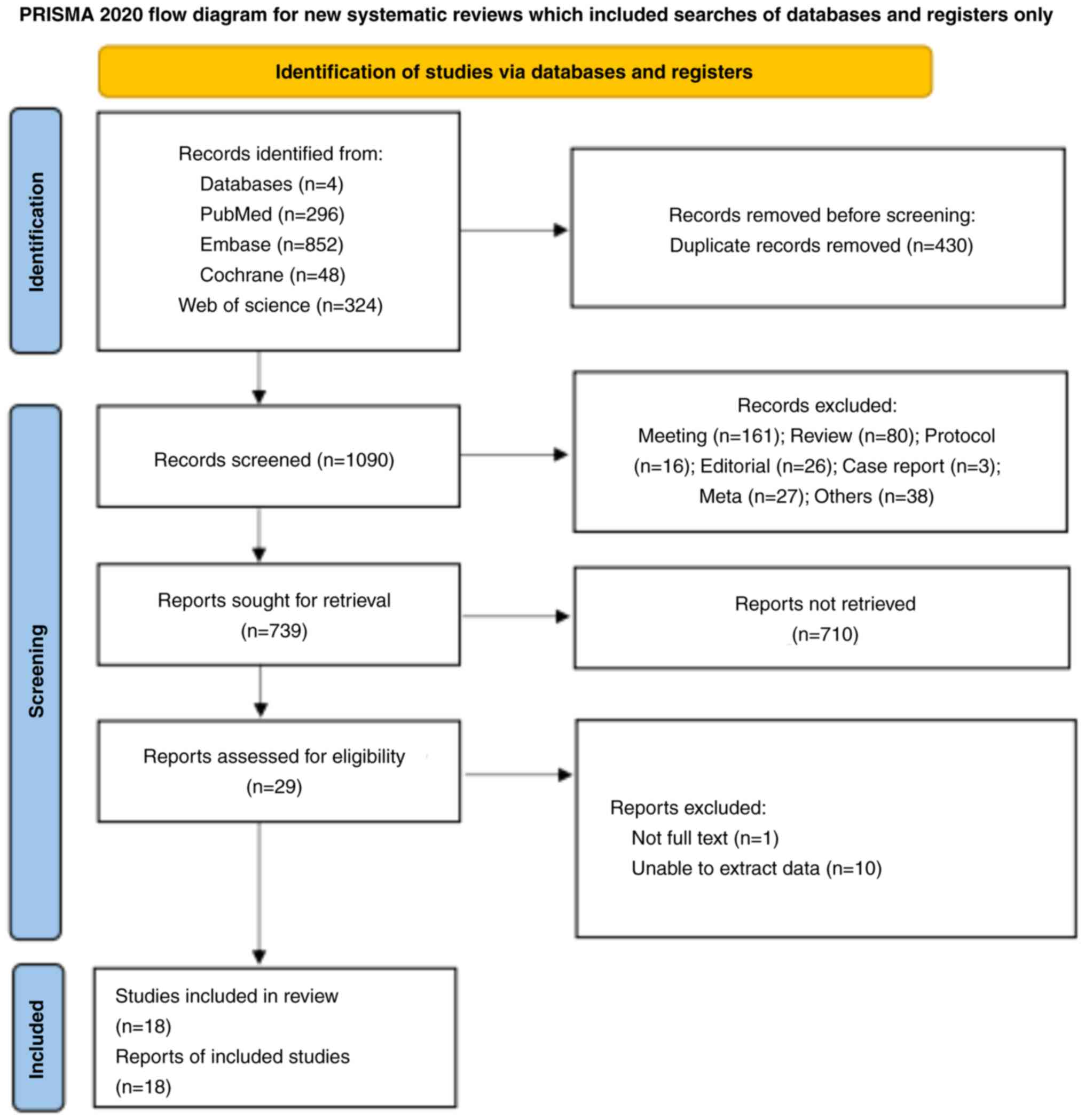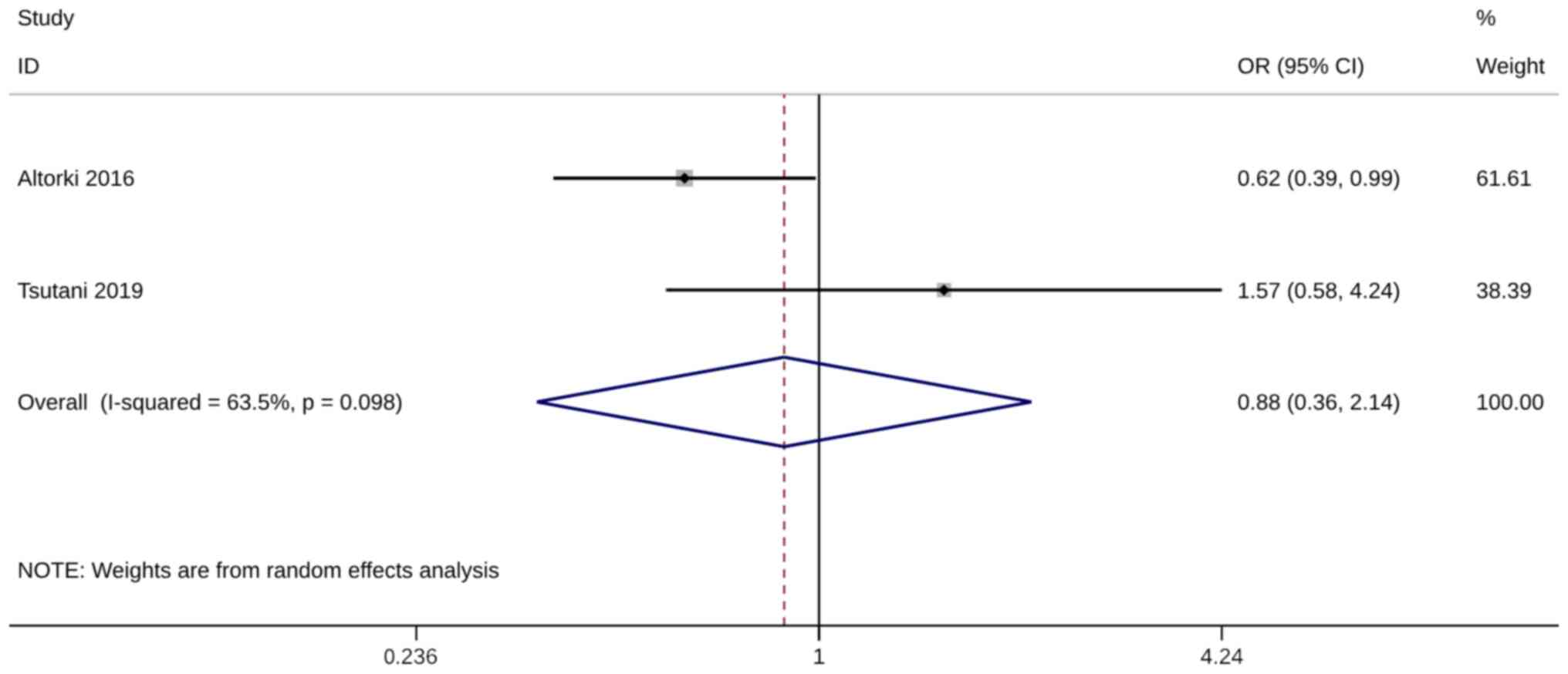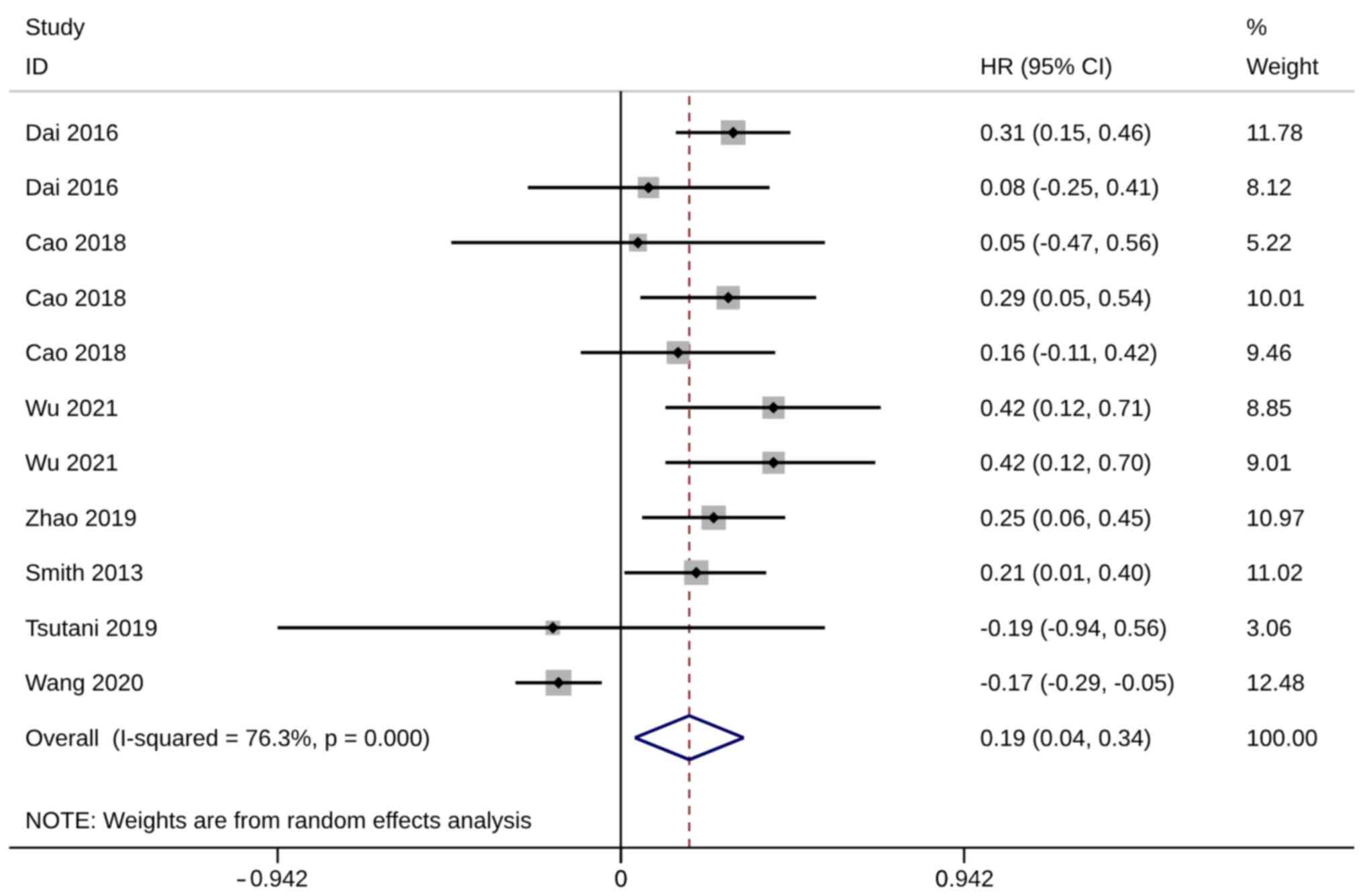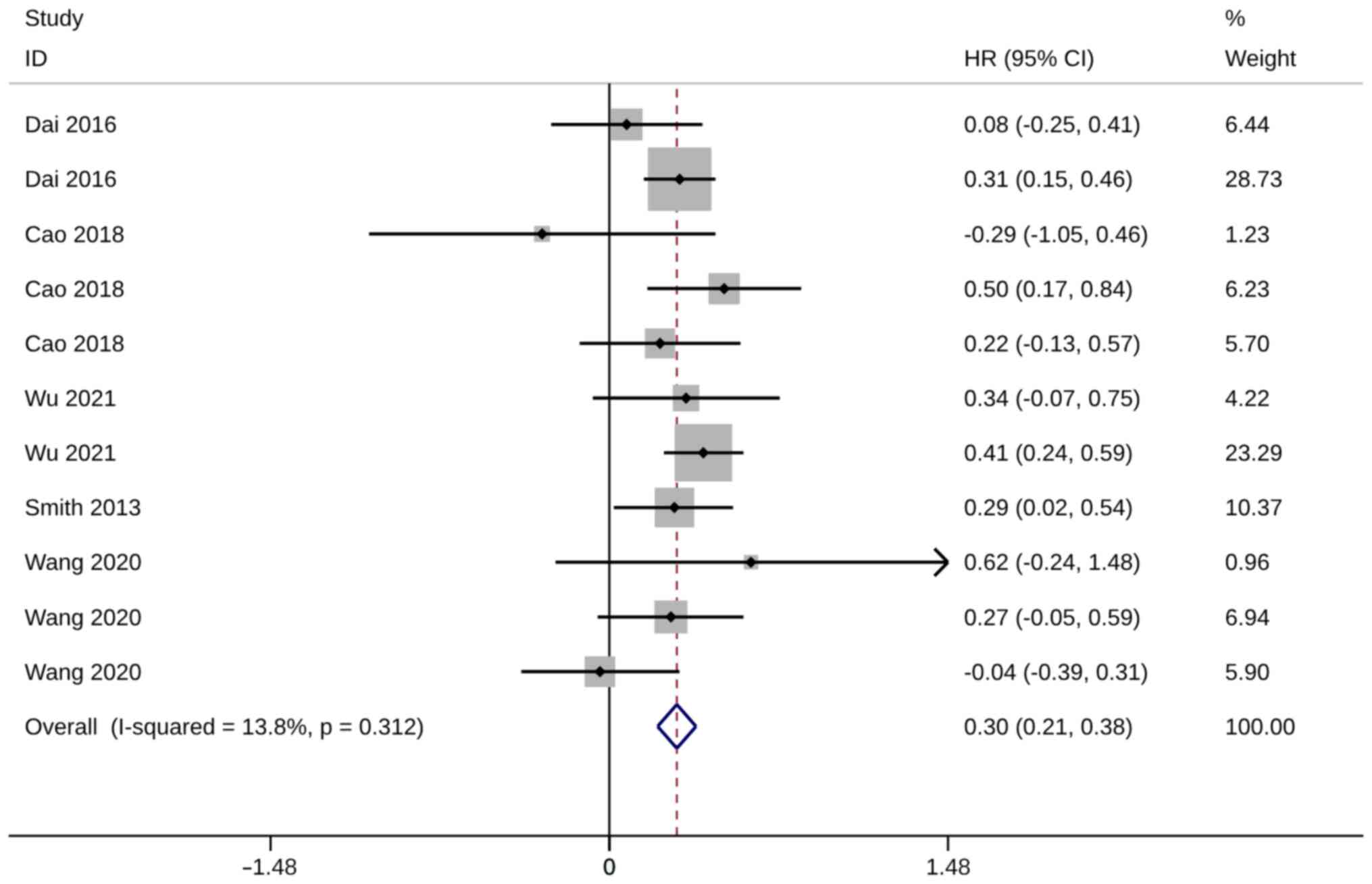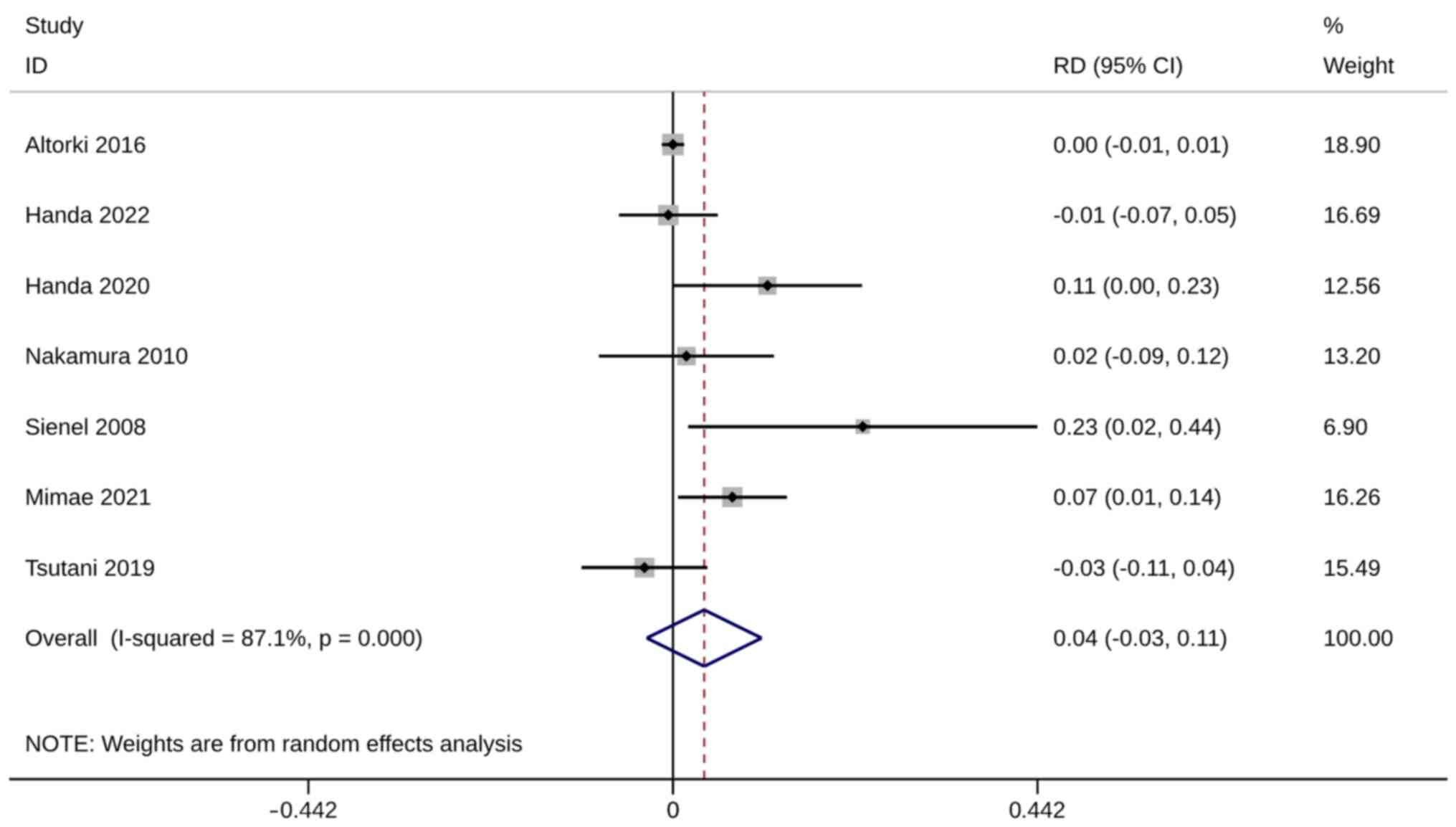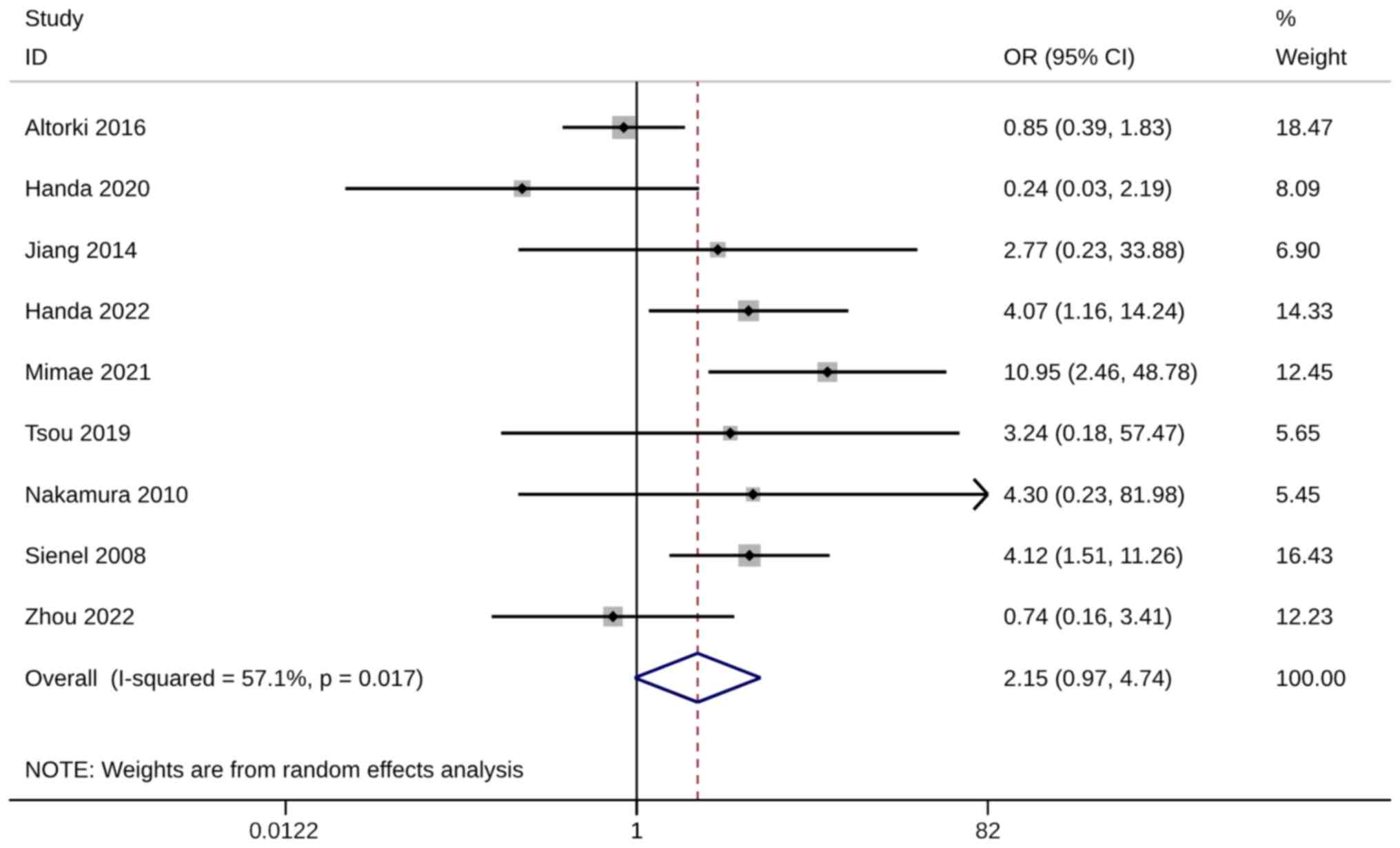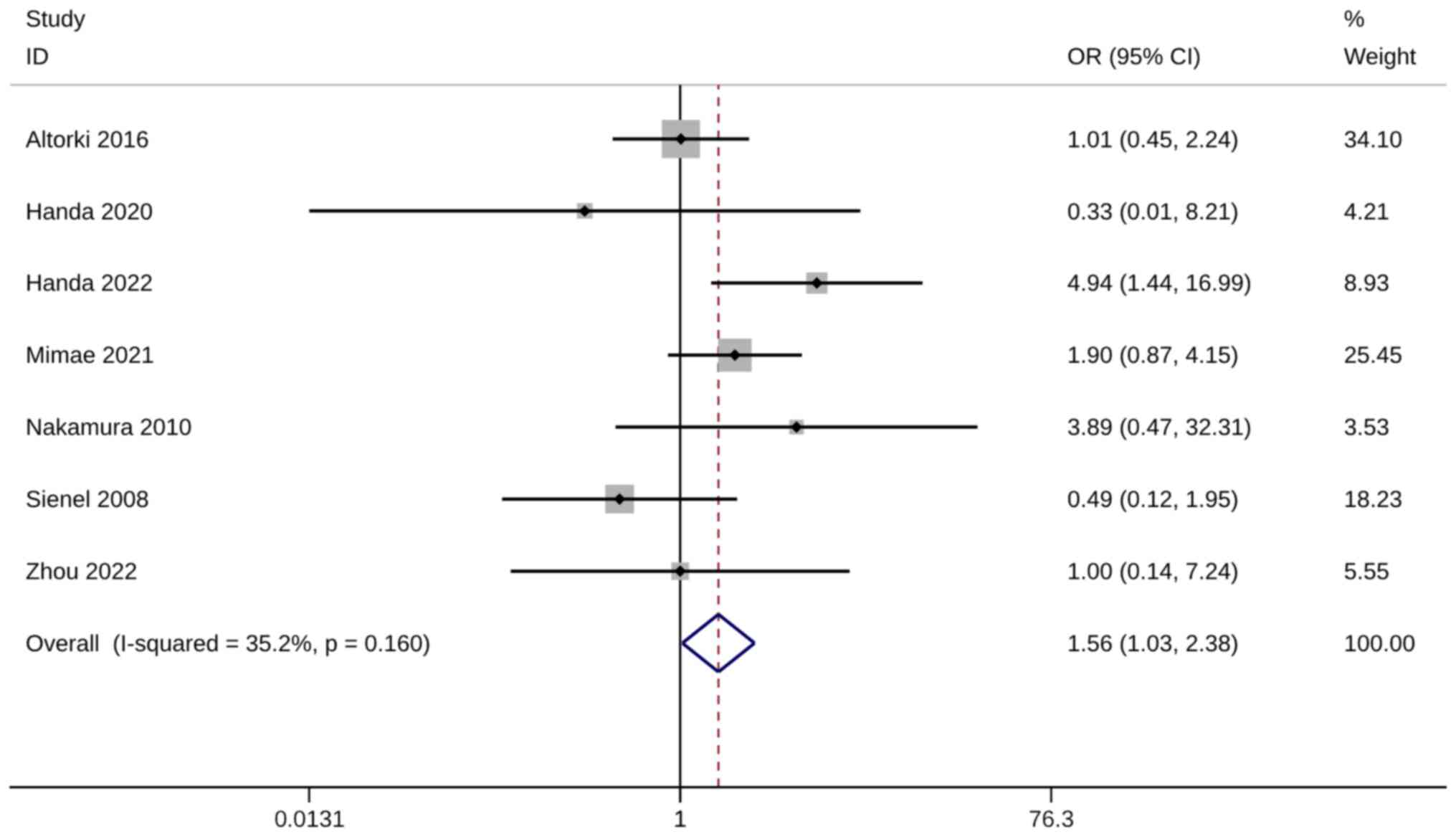Effectiveness and safety of segmentectomy vs. wedge resection for the treatment of patients with operable non‑small cell lung cancer: A meta‑analysis and systematic review
- Authors:
- Published online on: May 24, 2024 https://doi.org/10.3892/ol.2024.14469
- Article Number: 336
-
Copyright : © Xiu et al. This is an open access article distributed under the terms of Creative Commons Attribution License [CC BY 4.0].
Abstract
Introduction
Lung cancer is the 2nd most commonly diagnosed cancer after female breast cancer and the leading cause of cancer death worldwide. In 2020, there were 2.2 million new lung cancer cases and an estimated 1.8 million (18%) lung cancer-associated deaths globally (1). Surgery is the preferred treatment for early-stage lung cancer. With the development of modern techniques such as computed tomography screening and other imaging techniques, the early detection of smaller lesions has improved, increasing the number of surgeries (2). Lobectomy is usually recommended for patients with stage I non-small cell lung cancer (NSCLC) (3,4). Studies also confirmed that lobectomy combined with mediastinal lymph node dissection has a 5-year survival rate of ~60% (4,5). Considering that most patients with NSCLC are older, with a median age range diagnosis of 67.7–70 years (6,7), removing excess healthy tissue can seriously affect the patient's quality of life (8). Thus, alternative methods are recommended for these patients.
For those patients with severe comorbidities who cannot undergo lobectomy, segmentectomy (ST) and sublobectomy are currently being considered (9). In recent years, sublobectomy [ST or wedge resection (WR)] has gained attention since it can preserve lung function. WR is a nonanatomic procedure that removes the cancerous lung tissue surrounded by a margin of normal lung parenchyma. Its operation time is shorter because, during this procedure, the pulmonary vessels and bronchus do not need to be identified (10,11). By contrast, ST is an anatomic excision that requires the surgeon to carefully identify the location of the pulmonary blood vessels and bronchi. Due to the need for careful dissection and evaluation of intraparenchymal and hilar lymph nodes, ST is more technically demanding than WR (12). At present, WR is more commonly used than ST, accounting for ~80% of sublobectomy (13), but WR is generally considered less effective than anatomic ST for the following two reasons: i) In WR, lymph nodes in the tumor area are usually not removed immediately; and ii) the staple line edge of WR is closer to the tumor than that of ST (10). Various studies have produced inconsistent results regarding the impact of two surgical approaches i.e., WR and ST, on overall survival (OS) and lung cancer-specific survival (LCSS) in patients with operable NSCLC. Multiple studies have found no notable difference in OS or relapse-free survival between patients treated with ST and WR for NSCLC with ground glass opacity (GGO) as the primary clinical stage (14–17). Moreover, a meta-analysis of nine studies published in 2016 suggested that ST is associated with a higher OS rate than WR for patients with stage I NSCLC; however, no difference was observed for patients with stage IA NSCLC and tumors >2 cm in diameter (10). Another meta-analysis of 19 studies published in 2019 concluded that OS, LCSS and disease-free survival (DFS) after ST were markedly higher than those after WT in patients with NSCLC (18). In addition, recent clinical studies have shown that WR and ST are equally effective in NSCLC with a GGO diameter of 2–3 cm, with fewer complications, faster recovery of lung function and greater prevention of postoperative death from causes other than NSCLC (19,20). Still, this meta-analysis (18) only evaluated the difference between WR and ST in survival outcomes, and the latest studies (19,20) pointed out that WR may have clinically significant advantages in terms of postoperative complications, and recurrence and metastasis rates.
In the present study, a meta-analysis was performed to compare the outcomes of OS, LCSS, mortality, complication rate, recurrence and metastasis rates in patients with operable NSCLC receiving WR compared with those undergoing ST. These data further contribute to our understanding of surgical options for patients with NSCLC who received limited lung resection and provide more specific recommendations for clinical decision-making.
Materials and methods
Literature search
The current meta-analysis was performed according to the 2020 Preferred Reporting Items for Systematic Reviews and Meta-Analyses guidelines (21). The relevant articles were searched based on the population, intervention, comparison, outcomes and study principle (22). PubMed (https://pubmed.ncbi.nlm.nih.gov/), Embase (https://www.embase.com/), Web of Science (https://webofscience.com) and Cochrane Library (https://www.cochranelibrary.com/) were systematically searched for potentially eligible studies published from inception to July 2023, using the Medical Subject Headings terms ‘carcinoma, non-small-cell lung’, ‘pneumonectomy’, ‘sublobar resection’, ‘segmentectomy’ and ‘wedge resection’ and relevant keywords (Table SI). The literature retrieval and selection process were performed independently by two investigators and results were compared once the process was complete. Any discrepancy was solved by discussion.
Eligibility criteria
The inclusion criteria were: i) Studies reporting on patients with operable NSCLC; ii) the intervention group received WR, while a control group received ST; iii) study endpoints included OS, LCSS, mortality, recurrence, metastasis and postoperative complications; iv) no restrictions on study design; and v) full text available. The exclusion criteria were: i) Reviews, case reports, dissertations, conference papers, chapters in handbooks and editorials; ii) studies not published in an international peer-reviewed journal; and iii) duplicate published studies.
Data extraction
Two independent investigators performed data extraction. Any disagreements were resolved by a third reviewer. Data included the authors' name, publication year, study design and location, sample size, data sources, male proportion, mean age, stage of NSCLC, tumor size and study outcomes. The primary outcome was the 3- or 5-year OS, LCSS, mortality and postoperative complications; secondary outcomes included the recurrence and metastasis rates.
Quality assessment
Due to the particularity of intervention methods, complete double-blind, randomized controlled studies (RCTs) are challenging. ROBINS-I was selected to assess the risk of bias and quality of evidence in the included non-randomised studies of interventions (23). Quality assessment was performed in duplicate by investigators separately.
The contents of the study evaluation included the following: Bias due to confounding, bias in the selection of participants into the study, bias in classification of interventions, bias due to deviations from intended interventions, bias due to missing data, bias in the measurement of outcomes and bias in the selection of the reported result. The categories for risk of bias judgments were: ‘Low risk’, ‘Moderate risk, ‘Serious risk’ and ‘Critical risk’ of bias.
Statistical analysis
All analyses were performed using the Stata (version 15.1 SE; http://www.stata.com/stata15/). Odds ratios (ORs), hazard ratios (HRs), risk difference (RDs) and their corresponding 95% confidence intervals (Cis) were used to compare the outcomes. Studies providing 5-year OS numbers and 5-year OS HRs were separated for pooled analysis. For studies that reported effective sizes by subgroup, the subgroups were combined and the effect size for the entire sample was calculated. Statistical heterogeneity among the included studies was calculated using Cochran's Q-test, and the I2 index (I2>50% and Q-test P>0.10 indicated high heterogeneity). Given the clinical heterogeneity of the original studies (e.g., geographic, ethnic and others), the random effects model was used. P<0.05 was considered to indicate a statistically significant difference. A sensitivity analysis with a leave-one-out method was performed to assess the potential confounding effects and the robustness of the pooled results. If the pooled results after the exclusion of a study were inconsistent with the original pooled ones, the study was excluded as a potential confounder. Subgroup analysis was conducted to examine the survival outcome complications, and the recurrence and metastasis rates between WR and ST in different data sources [Surveillance, Epidemiology, and End Results (SEER) database or hospital], and tumor size (<1, 1–2, 2–3 and <3 cm). Publication bias was identified through the funnel plot, Egger regression and Begg tests.
Results
Study selection and characteristics
Fig. 1 presents the study selection process. The initial search resulted in 1,520 records. After removing 430 duplicates by automation tools and 1,062 records after reviewing the title and abstract, 29 studies were included. One study without a full text and 10 studies without interest outcomes were further excluded. Finally, 18 studies (19,20,24–39) were included in the current meta-analysis.
Table I shows the characteristics of the included studies. A total of 19,381 patients with operable NSCLC were included in the current meta-analysis; 14,611 in the WR group and 4,770 in the ST group. Studies were conducted in four countries, including America (n=2), China (n=10), Germany (n=1) and Japan (n=5). All of the included studies were retrospective. Nine studies had data from the SEER database, and the other nine obtained oncology data from hospitals. The mean age range of the included patients with operable NSCLC was 55.96–79.9 years. The range of female percentage was 30.3–79.09%. All of the patients with NSCLC included in the 12 studies that provided pathological staging of the tumor were evaluated as stage IA lung cancer. The mean tumor size range was 1.5–4 cm.
Study quality
Table II shows the risk of bias assessment results of the included studies. Only three included studies had a moderate risk of bias, while the remaining 15 studies had a low risk. The main consideration of the three studies with ‘moderate risk’ was a bias due to potential confounding factors.
OS
Data on the 3-(24,35) and 5-year OS (19,24,27,29,32, 35,37,38), and 5-year OS HRs (20,25,26,33,35,36,39) were extracted from the original studies to compare the postoperative OS of patients with operable NSCLC who received WR or ST. For patients with operable NSCLC, there was no significant difference in the 3- and 5-year OS numbers after WR and ST; yet, the 5-year OS rate after ST was higher than that in the WR group.
Several studies have examined the 3-year (n=2) (24,35) and 5-year (n=8) (19,24,27,29,32,35,37,38) OS numbers after WR or ST. The pooled analysis was only conducted when at least two adequately powered studies were available, and no significant difference in both survival numbers was observed between the WR and the ST group [(3-year OS, OR=0.88; 95% CI, 0.36, 2.14; P=0.782, I2=63.5%) and (5-year OS numbers: OR=0.90; 95% CI, 0.58, 1.40; P=0.649, I2=78.5%; Figs. 2 and 3)]. The sensitivity analysis results indicated that the meta-analysis findings were robust, with consistent results remaining unchanged even when excluding any single study (Fig. S1).
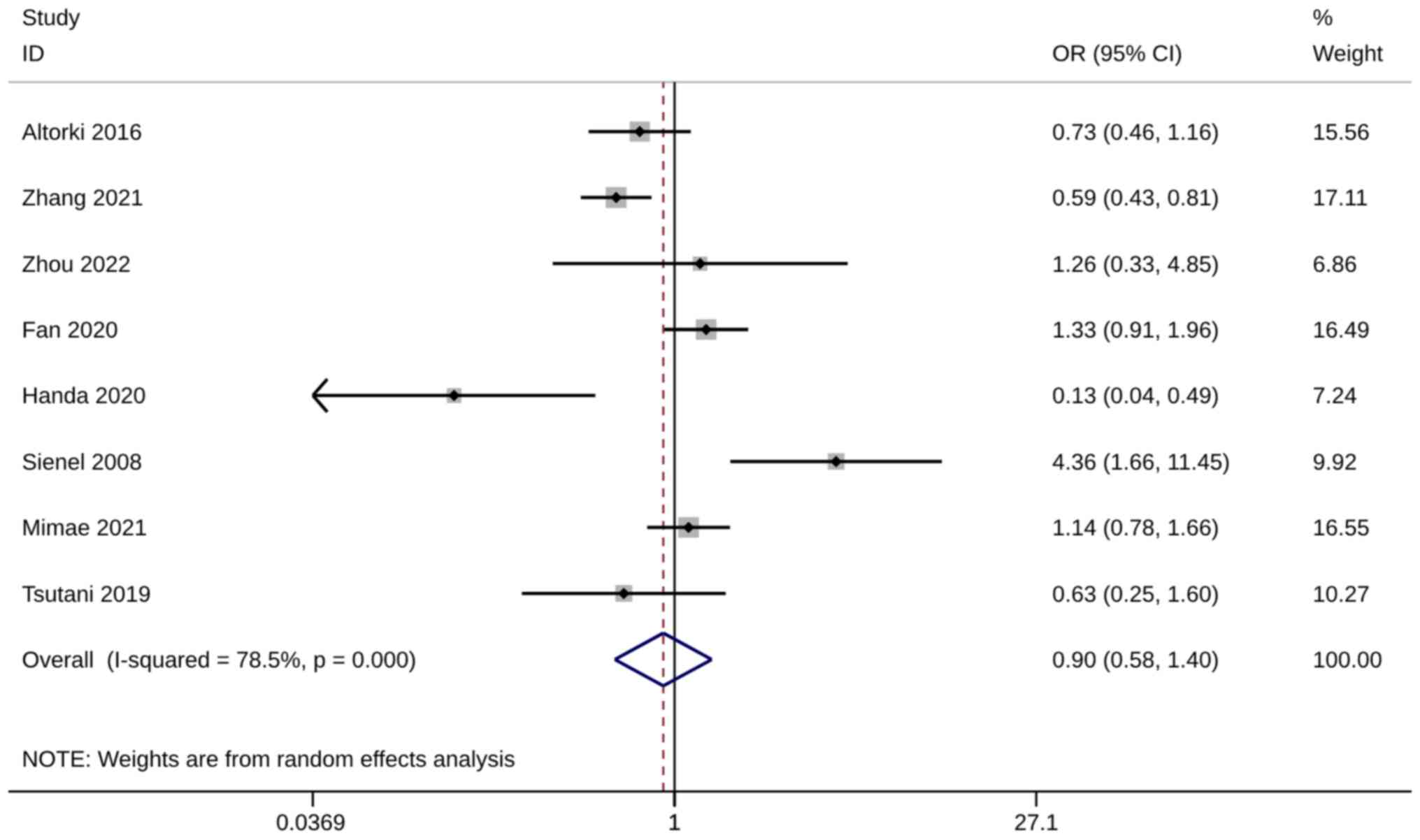 | Figure 3.Forest plot of numbers of 5-year overall survival. OR, odds ratio; CI, confidence interval. |
Seven studies with 11 trials (20,25,26,33,35,36,39), including 15,413 patients with operable NSCLC, reported on the HRs of 5-year OS. All these studies were included in the quantitative synthesis, and meta-analysis showed that with significant heterogeneity, 5-year OS was significantly higher after ST than after WR (HR, 0.19; 95% CI, 0.04, 0.34; P=0.014; I2=76.3%; Fig. 4). The sensitivity analysis results showed that the meta-analysis results were robust, and the advantage of ST remained unchanged when any one study was excluded (Fig. S2).
LCSS
Five studies with 11 trials reported on LCSS after operation. HR was used to compare LCSS between groups. Compared with the ST controls, significantly higher LCSS was observed in ST groups compared with WR groups (HR, 0.30; 95% CI, 0.21, 0.38; P<0.01). Heterogeneity was insignificant, so the fixed-effects model was used for the analysis (I2=13.8%; Fig. 5). Sensitivity analysis demonstrated the robustness of meta-analysis results since the advantage of ST remained unchanged after excluding any of these studies (Fig. S3).
Mortality
Mortality was evaluated using six studies with seven trials. No significant difference in mortality was observed between ST and WR groups (RD, 0.04; 95% CI, −0.03, 0.11; P=0.287). Heterogeneity was significant so the random-effects model was used for analysis (I2=87.1%; Fig. 6). The sensitivity analysis results were robust (Fig. S4).
Complications
Mortality was evaluated using six studies. There was no significant RD in complication incidence between ST and WR groups (OR, 0.72; 95% CI, 0.25, 2.07; P=0.536). Heterogeneity was significant so the random-effects model was used for analysis (I2=82%; Fig. 7). The sensitivity analysis showed that when Mimae et al (38) was excluded, the pooled results were inconsistent with the original meta-analysis results (Fig. S5). Mimae et al (38) may be the source of heterogeneity, and meta-analysis results after exclusion showed that the complication rate in the WR group was significantly lower than that in the ST group (OR, 0.44; 95% CI, 0.23, 0.82; Table SI, Table SII, Table SIII).
Recurrence rate
There were nine of the 18 included studies that compared recurrence rates between groups. No difference in recurrence rate was observed between ST and WR groups (OR, 2.15; 95% CI, 0.97, 4.74; P=0.058). Heterogeneity was significant so the random-effects model was used for analysis (I2=57.1%; Fig. 8). When the studies of Altorki et al (24), Handa et al (29) and Zhou et al (37) were excluded, the pooled results were inconsistent with the original meta-analysis results (Fig. S6). The aforementioned three included studies may be the source of heterogeneity, and meta-analysis results after exclusion showed that the recurrence rate in the WR group was significantly higher than in the ST group, with OR >1 and 95% CI not included 1 (Table SIII).
Metastasis rate
The metastasis rate was evaluated using six studies with seven trials. A significantly higher metastasis rate was observed in WR groups than in ST groups (OR, 1.56; 95% CI, 1.03, 2.38; P=0.037). Heterogeneity was not significant, so the fixed-effects model was used for analysis (I2=35.2%; Fig. 9). The sensitivity analysis results were robust (Fig. S7).
Data sources subgroup-analysis
Given the heterogeneity of NSCLC data sources, subgroup analysis divided studies into SEER database and hospital groups. Considering the number of studies, all subgroup analyses were performed using six outcome variables, excluding 3-year OS numbers and LCSS.
In the SEER database subgroups, the 5-year OS rate in the ST group was higher than that in the WR group (HR, 0.20; 95% CI, 0.05, 0.35; P=0.01; I2=78.3%; n=10; Fig. S8), and the complication rate in the WR group was lower than that in the ST group (OR, 0.56; 95% CI, 0.34, 0.94; P=0.027; n=1; Fig. S9). No difference was observed in other outcomes (Figs. S10 and 11).
In hospital subgroups, higher recurrence (OR, 2.71; 95% CI, 1.22, 6.02; P=0.015; n=8) and metastasis rate (OR, 1.85; 95% CI, 1.12, 3.05; P=0.016; n=6) were observed in WR subgroups compared with ST groups (Figs. S12 and 13).
Tumor size subgroup-analysis
Stratified by the average tumour size of enrolled patients with NSCLC, the study was divided into <1, 1–2, 2–3 and <3 cm, and not provided groups. Tumour size subgroup analyses were only performed for 5-year OS rate and LCSS.
For patients with NSCLC with tumor size <1 cm, LCSS in the ST group was superior to WR (HR, 0.3; 95% CI, 0.16, 0.44; P<0.01; n=4), while there was no difference in 5-year OS rate (HR, 0.22; 95% CI, −0.03, 0.47; P=0.089; n=3). When the tumor size was 1–2 cm, the 5-year OS rate (HR, 0.32; 95% CI, 0.20, 0.44; P<0.01; n=3; Fig. S14) and LCSS (OR, 0.35; 95% CI, 0.22, 0.48; P<0.01; n=4; Fig. S15) in the ST group were better than those in the WR group. In patients with NSCLC with tumor size <3 cm, the 5-year OS rate in the WR group was higher (HR, −0.17; 95% CI, −0.29, −0.05; P=0.005; n=1) and the LCSS was lower than that in the ST group (HR, 0.29; 95% CI, 0.02, 0.55; P=0.032; n=1). There was no difference in OS rate and LCSS 5 years after WR or ST in patients with tumor size 2–3 cm (Figs. S14 and 15).
Publication bias and sensitivity analysis
Publication bias was assessed using a funnel plot, Egger regression test, Begg test and trim and fill method. According to Fig. S16, Fig. S17, Fig. S18, Fig. S19, Fig. S20, Fig. S21, Fig. S22, the Egger regression test and the Begg test results, no publication bias was observed in all primary or secondary outcomes (Table SII).
The results of the sensitivity analysis found that Mimae et al (38) may be the source of heterogeneity in complication rate (Fig. S5), and Altorki et al (24), Handa et al (28), or Zhou et al (37) were identified as the potential confounders of recurrence rate (Fig. S6).
Discussion
A sublobar resection, which includes ST and WR, is considered a possible alternative to lobectomy (33), especially for patients with stage I NSCLC (40). Yet, specific target populations and postoperative prognostic outcomes of ST and WR remain controversial (32).
After excluding possible confounders, the findings of the present study suggest that 5-year OS, LCSS and metastasis rates in patients with operable NSCLC treated with WR are worse than those in patients treated with ST. However, the incidence of postoperative complications in WR patients was significantly lower than in the ST treatment group. Based on current evidence, ST may be the best option for patients with NSCLC whose tumor size range of 1–2 cm in terms of postoperative OS and LCSS. Clinical data from hospitals can better support the advantages of ST surgical methods in recurrence and metastasis rates. Also, the results related to postoperative survival in patients with NSCLC who received WR and ST were consistent with previous meta-analyses (10,12,18).
Numerous previous studies have compared the outcomes of patients with stage I NSCLC undergoing cuneiform and ST (10,18,41). The findings of the current study on OS and LCSS are consistent with those studies. Hou et al (10) analyzed 19 studies (3,604 patients receiving ST and 10,593 receiving WR) and concluded that survival and LCSS were higher for ST than for WR. Mata-analysis results published by Zhang et al (18) suggested that ST had markedly better OS, LCSS and DFS than WR in patients with stage I NSCLC who underwent lobectomy. Moreover, a Bayesian network meta-analysis published in 2022 showed that ST has marked benefits compared with WR for OS and DFS in patients with early-stage NSCLC (41). At the same time, compared with the aforementioned studies, the present meta-analysis included more recent research results, and the analysis results were more convincing. Previous studies have only included a limited number of original documents and these documents are quite old. The present study included 18 recent documents, which will make the findings more convincing. In addition, the previous studies are compared in the following paragraphs. By comparing a previously published study (29) and review (10), it was shown that recently published studies (29) report different results compared with older studies (10). For example, Hou et al (10) found comparable results between ST and WR with regards to OS when assessing studies published between 2005 and 2010, but OS was also higher for ST than WR when assessing studies published between 2010 and 2015, which may be due to the continuous improvement and development of ST surgical techniques. A study published in Handa in 2022 comparing the survival outcomes of complex ST and WR when lobectomy is not possible, lung cancer with a ‘complex site’ solid component size ≤2.0 cm may require complex ST instead of WR (29). This complex ST requires the surgeon to separate and segment the appropriate segmental bronchi, arteries and veins more peripherally and, in some cases, to cut into the lung parenchyma. Several intersegmental planes with safe surgical margins must be made. Compared with WR resection of lung tumors with normal parenchymal margins, the aforementioned procedure can effectively improve the postoperative survival of patients. Meanwhile, a more recent study has further findings on the size of the tumors suitable for the two surgeries. In their meta-analysis, Hou et al (10) suggested that the larger the tumor size for patients with stage I NSCLC, the greater the advantage of ST over WR. Both meta-analyses were published later, and the present study found no difference in the effect of ST and WR on survival outcomes in patients with NSCLC with tumor sizes >2 cm.
For some types of tumors, the recurrence rate depends primarily on the appropriateness of selecting the initial surgical resection area (42). There is an idea that patients who undergo limited resection, WR or ST, have a markedly increased risk of intrathoracic recurrence (43,44). Another view is that there is no notable difference in survival between patients with stage I NSCLC undergoing sublobectomy (cuneiform resection and ST) and standard lobectomy, especially for early NSCLC (45,46). NSCLC is a malignancy that affects mainly the elderly, and the removal of excess healthy tissue can seriously affect the patient's quality of life (6,8). The present meta-analysis aimed not to select the best surgical resection between WR and ST, but to clarify whether WR has the same survival, recurrence and metastasis rates as ST as WR preserves more normal tissue (14). The current results suggest that WR, which preserves more normal tissue, may not be prioritized when both resection methods are suitable for patients.
For patients with NSCLC, the choice of postoperative recurrence is more relevant than the choice of surgical resection margin. Sato et al (47) demonstrated that the accurate identification of adequate surgical margins plays a crucial role in preventing recurrence at the margins. Although no conclusion has been reached, it is hypothesised that 20-mm incision margin for a full lung and 15-mm incision margin for a depleted lung are the appropriate choices (48). Tsutani et al (49) compared cancer control between ST and WR in patients with clinical stage IA NSCLC and found that 36/195 (18.5%) patients undergoing WR and 14/262 (5.3%) patients undergoing ST experienced recurrence after surgery. ST has better tumor control than WR. Suzuki et al (50) reported that the median incision margin of pathological surgery was 15 mm, and the 5-year recurrence-free survival rate was 99.7%. Sublobectomy with adequate surgical margins provides adequate local control and recurrence-free survival for clinically resectable lung cancer. Zhou et al (37) showed that WR may be better suited for peripheral lesions, whereas ST is better suited for deeper lesions that cannot be accessed by WR.
Adequate lymph node dissection is the key to preventing metastasis and recurrence. For patients with early NSCLC ≥3 cm in diameter, evaluated lymph nodes in patients undergoing sublobectomy are associated with better OS and LCSS (51). Baig et al (52) reported that ST has a higher long-term survival rate than WR for second primary lung cancer after a prior lobectomy. WR for second primary lung cancer markedly improves OS when adequate lymph node dissection is performed.
The results of the study showed that the outcomes of WR in terms of survival, recurrence and metastasis were not favourable; however, a study by Handa et al (29) included demonstrated generally lower toxicity and a significantly lower incidence of postoperative complications in WR as compared to the ST group. Regarding short-term surgical outcomes such as surgical time, surgical blood loss and postoperative hospital stay, WR is less damaging than ST (29). Similar to previous findings, WR had 3.15 fewer complications than ST. Notably, there were no serious postoperative complications, and postoperative mortality was comparable to ST (29), which also provides surgical options for patients with early NSCLC who are older or have severe comorbidities.
The present study has some limitations. First, a large amount of retrospective data can bring uncertainty and concerns to a conclusion; thus, more prospective studies and RCTs are needed to make up for this shortcoming. Second, a great heterogeneity in the included studies may lead to some bias. Third, specific surgical methods for different ST and WR, such as complex ST and simple ST included in the studies, were not discussed. Also, due to limited original data, the current study did not conduct a subgroup analysis of patients of different ages, which could have further refined the target population of different surgical methods.
A meta-analysis, which was published in 2019, incorporated 15 studies, four of which were prospective (18). Although the number of studies included in the present study is lower than that of the study of Zhang et al (18), the time range of the literature search has been extended from before April 30, 2018 to July 2023. The 16 studies included in the Bayesian meta-analysis published in 2022 were all retrospective studies, similar to those in the current study (41). Therefore, in terms of the included studies, it is hypothesised that the present meta-analysis is just as compelling as previous meta-analyses. As a result, it contributes to the exploration of postoperative recurrence and metastasis of NSCLC, which is somewhat innovative.
The data of the current study suggest that the postoperative survival rate of patients with operable NSCLC after WT is not equivalent to that of ST; however, the postoperative complication rate of WT is lower than that of ST. The equivalence of recurrence rate and distant metastasis rate remains controversial. Practitioners should not blindly use WT instead of ST in clinical practice. More prospective studies and RCTs are needed to further analyse the differences in recurrence and metastasis rates between ST and WR surgical modalities.
Supplementary Material
Supporting Data
Supporting Data
Acknowledgements
Not applicable.
Funding
Funding: No funding was received.
Availability of data and materials
The data generated in the present study are included in the figures and/or tables of this article.
Authors' contributions
JX, SX and SW conceived the study idea and designed the study. SX provided administrative support and study materials or patients. JX, SW, XW, WX, YHu and YHua collected and assembled the data. JH, SW and XW analyzed and interpreted the data. All authors contributed to the writing of the manuscript. JX, SW and SX confirm the authenticity of all the raw data. All authors have read and approved the final version of the manuscript.
Ethics approval and consent to participate
Not applicable.
Patient consent for publication
Not applicable.
Competing interests
The authors declare that they have no competing interests.
References
|
Sung H, Ferlay J, Siegel RL, Laversanne M, Soerjomataram I, Jemal A and Bray F: Global cancer statistics 2020: GLOBOCAN estimates of incidence and mortality worldwide for 36 cancers in 185 countries. CA Cancer J Clin. 71:209–249. 2021. View Article : Google Scholar : PubMed/NCBI | |
|
Forquer JA, Fakiris AJ, McGarry RC, Cheung MK, Watson C, Harkenrider M, Henderson MA and Lo SS: Treatment options for stage I non-small-cell lung carcinoma patients not suitable for lobectomy. Expert Rev Anticancer Ther. 9:1443–1153. 2009. View Article : Google Scholar : PubMed/NCBI | |
|
Scott WJ, Howington J, Feigenberg S, Movsas B and Pisters K; American College of Chest Physicians, : Treatment of non-small cell lung cancer stage I and stage II: ACCP evidence-based clinical practice guidelines (2nd edition). Chest. 132 (Suppl):S234–S242. 2007. View Article : Google Scholar | |
|
Nakamura H, Kazuyuki S, Kawasaki N, Taguchi M and Kato H: History of limited resection for non-small cell lung cancer. Ann Thorac Cardiovasc Surg. 11:356–362. 2005.PubMed/NCBI | |
|
Martini N, Bains MS, Burt ME, Zakowski MF, McCormack P, Rusch VW and Ginsberg RJ: Incidence of local recurrence and second primary tumors in resected stage I lung cancer. J Thorac Cardiovasc Surg. 109:120–129. 1995. View Article : Google Scholar : PubMed/NCBI | |
|
Jatoi A, Schild SE, Foster N, Henning GT, Dornfeld KJ, Flynn PJ, Fitch TR, Dakhil SR, Rowland KM, Stella PJ, et al: A phase II study of cetuximab and radiation in elderly and/or poor performance status patients with locally advanced non-small-cell lung cancer (N0422). Ann Oncol. 21:2040–2044. 2010. View Article : Google Scholar : PubMed/NCBI | |
|
Heiden BT, Eaton DB Jr, Engelhardt KE, Chang SH, Yan Y, Patel MR, Kreisel D, Nava RG, Meyers BF, Kozower BD and Puri V: Analysis of delayed surgical treatment and oncologic outcomes in clinical stage I non-small cell lung cancer. JAMA Netw Open. 4:e21116132021. View Article : Google Scholar : PubMed/NCBI | |
|
Celli JP, Spring BQ, Rizvi I, Evans CL, Samkoe KS, Verma S, Pogue BW and Hasan T: Imaging and photodynamic therapy: Mechanisms, monitoring, and optimization. Chem Rev. 110:2795–2838. 2010. View Article : Google Scholar : PubMed/NCBI | |
|
Cao C, Gupta S, Chandrakumar D, Tian DH, Black D and Yan TD: Meta-analysis of intentional sublobar resections versus lobectomy for early stage non-small cell lung cancer. Ann Cardiothorac Surg. 3:134–141. 2014.PubMed/NCBI | |
|
Hou B, Deng XF, Zhou D, Liu QX and Dai JG: Segmentectomy versus wedge resection for the treatment of high-risk operable patients with stage I non-small cell lung cancer: A meta-analysis. Ther Adv Respir Dis. 10:435–443. 2016. View Article : Google Scholar : PubMed/NCBI | |
|
Ding H, Song N, Zhang P, Jiang G and Wang H: Wedge resection plus adequate lymph nodes resection is comparable to lobectomy for small-sized non-small cell lung cancer. Front Oncol. 12:10229042022. View Article : Google Scholar : PubMed/NCBI | |
|
Detterbeck FC, Mase VJ Jr, Li AX, Kumbasar U, Bade BC, Park HS, Decker RH, Madoff DC, Woodard GA, Brandt WS and Blasberg JD: A guide for managing patients with stage I NSCLC: Deciding between lobectomy, segmentectomy, wedge, SBRT and ablation-part 2: Systematic review of evidence regarding resection extent in generally healthy patients. J Thorac Dis. 14:2357–2386. 2022. View Article : Google Scholar : PubMed/NCBI | |
|
Ding H, Wang H, Xu L, Song N and Jiang G: Survival and resected lymph node number during sublobar resection for n0 non-small cell lung cancer 2 cm or less. Ann Thorac Surg. 107:1647–1655. 2019. View Article : Google Scholar : PubMed/NCBI | |
|
Tsutani Y, Miyata Y, Nakayama H, Okumura S, Adachi S, Yoshimura M and Okada M: Appropriate sublobar resection choice for ground glass opacity-dominant clinical stage IA lung adenocarcinoma: Wedge resection or segmentectomy. Chest. 145:66–71. 2014. View Article : Google Scholar : PubMed/NCBI | |
|
Fiorelli A, Caronia FP, Daddi N, Loizzi D, Ampollini L, Ardò N, Ventura L, Carbognani P, Potenza R and Ardissone F: Sublobar resection versus lobectomy for stage I non-small cell lung cancer: An appropriate choice in elderly patients? Surg Today. 46:1370–1382. 2016. View Article : Google Scholar : PubMed/NCBI | |
|
Hamatake D, Yoshida Y, Miyahara S, Yamashita S, Shiraishi T and Iwasaki A: Surgical outcomes of lung cancer measuring less than 1 cm in diameter. Interact Cardiovasc Thorac Surg. 15:854–858. 2012. View Article : Google Scholar : PubMed/NCBI | |
|
Kent MS, Mandrekar SJ, Landreneau R, Nichols F, Foster NR, DiPetrillo TA, Meyers B, Heron DE, Jones DR, Tan AD, et al: A nomogram to predict recurrence and survival of high-risk patients undergoing sublobar resection for lung cancer: An analysis of a multicenter prospective study (ACOSOG Z4032). Ann Thorac Surg. 102:239–246. 2016. View Article : Google Scholar : PubMed/NCBI | |
|
Zhang H, Liu C, Tan Z and Zhang T: Segmentectomy versus wedge resection for stage I non-small cell lung cancer: A meta-analysis. J Surg Res. 243:371–379. 2019. View Article : Google Scholar : PubMed/NCBI | |
|
Zhang X, Lin G and Li J: Comparative effectiveness of lobectomy, segmentectomy, and wedge resection for pathological stage I non-small cell lung cancer in elderly patients: A population-based study. Front Surg. 8:6527702021. View Article : Google Scholar : PubMed/NCBI | |
|
Wang W, Sun Y, Li H, Bao M, Liu X, Jiang G, Ye C and Hu Y: Surgical modality for stage IA non-small cell lung cancer among the elderly: Analysis of the surveillance, epidemiology, and end results database. J Thorac Dis. 12:6731–6742. 2020. View Article : Google Scholar : PubMed/NCBI | |
|
Page MJ, McKenzie JE, Bossuyt PM, Boutron I, Hoffmann TC, Mulrow CD, Shamseer L, Tetzlaff JM, Akl EA, Brennan SE, et al: The PRISMA 2020 statement: An updated guideline for reporting systematic reviews. BMJ. 372:n712021. View Article : Google Scholar : PubMed/NCBI | |
|
Aslam S and Emmanuel P: Formulating a researchable question: A critical step for facilitating good clinical research. Indian J Sex Transm Dis AIDS. 31:47–50. 2010. View Article : Google Scholar : PubMed/NCBI | |
|
Sterne JA, Hernán MA, Reeves BC, Savović J, Berkman ND, Viswanathan M, Henry D, Altman DG, Ansari MT, Boutron I, et al: ROBINS-I: A tool for assessing risk of bias in non-randomised studies of interventions. BMJ. 355:i49192016. View Article : Google Scholar : PubMed/NCBI | |
|
Altorki NK, Kamel MK, Narula N, Ghaly G, Nasar A, Rahouma M, Lee PC, Port JL and Stiles BM: Anatomical segmentectomy and wedge resections are associated with comparable outcomes for patients with small cT1N0 non-small cell lung cancer. J Thorac Oncol. 11:1984–1992. 2016. View Article : Google Scholar : PubMed/NCBI | |
|
Cao J, Yuan P, Wang Y, Xu J, Yuan X, Wang Z, Lv W and Hu J: Survival rates after lobectomy, segmentectomy, and wedge resection for non-small cell lung cancer. Ann Thorac Surg. 105:1483–1491. 2018. View Article : Google Scholar : PubMed/NCBI | |
|
Dai C, Shen J, Ren Y, Zhong S, Zheng H, He J, Xie D, Fei K, Liang W, Jiang G, et al: Choice of surgical procedure for patients with non-small-cell lung cancer ≤1 cm or >1 to 2 cm among lobectomy, segmentectomy, and wedge resection: A population-based study. J Clin Oncol. 34:3175–3182. 2016. View Article : Google Scholar : PubMed/NCBI | |
|
Fan X, Liang Y, Bai Y, Yang C and Xu S: Conditional survival rate estimates of lobectomy, segmentectomy and wedge resection for stage IA1 non-small cell lung cancer: A population-based study. Oncol Lett. 20:1607–1618. 2020. View Article : Google Scholar : PubMed/NCBI | |
|
Handa Y, Tsutani Y, Mimae T, Miyata Y, Shimada Y, Ito H, Nakayama H, Ikeda N and Okada M: A multicenter study of complex segmentectomy versus wedge resection in clinical stage 0-IA non-small cell lung cancer. Clin Lung Cancer. 23:393–401. 2022. View Article : Google Scholar : PubMed/NCBI | |
|
Handa Y, Tsutani Y, Mimae T, Miyata Y and Okada M: Surgical procedure selection for stage I lung cancer: Complex segmentectomy versus wedge resection. Clin Lung Cancer. 22:e224–e233. 2021. View Article : Google Scholar : PubMed/NCBI | |
|
Jiang W, Pang X, Xi J, Chen X, Wang Q, Qian C and Fan H: Clinical outcome of subcentimeter non-small cell lung cancer after surgical resection: Single institution experience of 105 patients. J Surg Oncol. 110:233–238. 2014. View Article : Google Scholar : PubMed/NCBI | |
|
Nakamura H, Taniguchi Y, Miwa K, Adachi Y, Fujioka S, Haruki T, Takagi Y and Yurugi Y: Comparison of the surgical outcomes of thoracoscopic lobectomy, segmentectomy, and wedge resection for clinical stage I non-small cell lung cancer. Thorac Cardiovasc Surg. 59:137–141. 2011. View Article : Google Scholar : PubMed/NCBI | |
|
Sienel W, Dango S, Kirschbaum A, Cucuruz B, Hörth W, Stremmel C and Passlick B: Sublobar resections in stage IA non-small cell lung cancer: Segmentectomies result in significantly better cancer-related survival than wedge resections. Eur J Cardiothorac Surg. 33:728–734. 2008. View Article : Google Scholar : PubMed/NCBI | |
|
Smith CB, Swanson SJ, Mhango G and Wisnivesky JP: Survival after segmentectomy and wedge resection in stage I non-small-cell lung cancer. J Thorac Oncol. 8:73–78. 2013. View Article : Google Scholar : PubMed/NCBI | |
|
Tsou KC, Hsu HH, Tsai TM, Chen KC and Chen JS: Clinical outcome of subcentimeter non-small cell lung cancer after VATS resection: Single institute experience with 424 patients. J Formos Med Assoc. 119:399–405. 2020. View Article : Google Scholar : PubMed/NCBI | |
|
Tsutani Y, Kagimoto A, Handa Y, Mimae T, Miyata Y and Okada M: Wedge resection versus segmentectomy in patients with stage I non-small-cell lung cancer unfit for lobectomy. Jpn J Clin Oncol. 49:1134–1142. 2019. View Article : Google Scholar : PubMed/NCBI | |
|
Wu L, Zhao W, Chen T and Yang Y: Surgical choice for patients with stage I non-small-cell lung cancer ≤2 cm: An analysis from surveillance, epidemiology, and end results database. J Cardiothorac Surg. 16:1912021. View Article : Google Scholar : PubMed/NCBI | |
|
Zhou Y, Yu T, Zhang Y, Qian L and Xia Q: Comparison of surgical outcomes and prognosis between wedge resection and simple Segmentectomy for GGO diameter between 2 cm and 3 cm in non-small cell lung cancer: A multicenter and propensity score matching analysis. BMC Cancer. 22:712022. View Article : Google Scholar : PubMed/NCBI | |
|
Mimae T, Saji H, Nakamura H, Okumura N, Tsuchida M, Sonobe M, Miyazaki T, Aokage K, Nakao M, Haruki T, et al: Survival of octogenarians with early-stage non-small cell lung cancer is comparable between wedge resection and lobectomy/segmentectomy: JACS1303. Ann Surg Oncol. 28:7219–7227. 2021. View Article : Google Scholar : PubMed/NCBI | |
|
Zhao M, Lu T, Huang Y, Yin J, Jiang T, Li M, Yang X, Zhan C, Feng M and Wang Q: Survival and long-term cause-specific mortality associated with stage IA lung adenocarcinoma after wedge resection vs. segmentectomy: A population-based propensity score matching and competing risk analysis. Front Oncol. 9:5932019. View Article : Google Scholar : PubMed/NCBI | |
|
Ettinger DS, Wood DE, Aisner DL, Akerley W, Bauman J, Chirieac LR, D'Amico TA, DeCamp MM, Dilling TJ, Dobelbower M, et al: Non-small cell lung cancer, version 5.2017, NCCN clinical practice guidelines in oncology. J Natl Compr Canc Netw. 15:504–535. 2017. View Article : Google Scholar : PubMed/NCBI | |
|
Shi Y, Wu S, Ma S, Lyu Y, Xu H, Deng L and Chen X: Comparison between wedge resection and lobectomy/segmentectomy for early-stage non-small cell lung cancer: A bayesian meta-analysis and systematic review. Ann Surg Oncol. 29:1868–1879. 2022. View Article : Google Scholar : PubMed/NCBI | |
|
Hoebeke PB, Rottey S, Van Heddeghem N, Villeirs G, Pauwels P, Schrauwen W, Ceulemans P and Monstrey S: One-stage penectomy and phalloplasty for epithelioid sarcoma of the penis in an adolescent: Part 2. Eur Urol. 51:1744–1747. 2007. View Article : Google Scholar : PubMed/NCBI | |
|
Stish BJ, Hallemeier CL, Olivier KR, Harmsen WS, Allen MS and Garces YI: Long-term outcomes and patterns of failure after surgical resection of small-cell lung cancer. Clin Lung Cancer. 16:e67–e73. 2015. View Article : Google Scholar : PubMed/NCBI | |
|
Patnaik SK, Kannisto E, Knudsen S and Yendamuri S: Evaluation of microRNA expression profiles that may predict recurrence of localized stage I non-small cell lung cancer after surgical resection. Cancer Res. 70:36–45. 2010. View Article : Google Scholar : PubMed/NCBI | |
|
Wu Y, Han C, Wang Z, Gong L, Liu J, Chong Y, Liu X, Liang N and Li S: An externally-validated dynamic nomogram based on clinicopathological characteristics for evaluating the risk of lymph node metastasis in small-size non-small cell lung cancer. Front Oncol. 10:13222020. View Article : Google Scholar : PubMed/NCBI | |
|
Altorki NK, Yip R, Hanaoka T, Bauer T, Aye R, Kohman L, Sheppard B, Thurer R, Andaz S, Smith M, et al: Sublobar resection is equivalent to lobectomy for clinical stage 1A lung cancer in solid nodules. J Thorac Cardiovasc Surg. 147:754–762. 2014. View Article : Google Scholar : PubMed/NCBI | |
|
Sato M, Kobayashi M, Kojima F, Tanaka F, Yanagiya M, Kosaka S, Fukai R and Nakajima J: Effect of virtual-assisted lung mapping in acquisition of surgical margins in sublobar lung resection. J Thorac Cardiovasc Surg. 156:1691–1701.e5. 2018. View Article : Google Scholar : PubMed/NCBI | |
|
Kadota K, Nitadori JI, Sima CS, Ujiie H, Rizk NP, Jones DR, Adusumilli PS and Travis WD: Tumor spread through air spaces is an important pattern of invasion and impacts the frequency and location of recurrences after limited resection for small stage I lung adenocarcinomas. J Thorac Oncol. 10:806–814. 2015. View Article : Google Scholar : PubMed/NCBI | |
|
Tsutani Y, Handa Y, Shimada Y, Ito H, Ikeda N, Nakayama H, Yoshimura K and Okada M: Comparison of cancer control between segmentectomy and wedge resection in patients with clinical stage IA non-small cell lung cancer. J Thorac Cardiovasc Surg. 162:1244–1252.e1. 2021. View Article : Google Scholar : PubMed/NCBI | |
|
Suzuki K, Watanabe SI, Wakabayashi M, Saji H, Aokage K, Moriya Y, Yoshino I, Tsuboi M, Nakamura S, Nakamura K, et al: A single-arm study of sublobar resection for ground-glass opacity dominant peripheral lung cancer. J Thorac Cardiovasc Surg. 163:289–301.e2. 2022. View Article : Google Scholar : PubMed/NCBI | |
|
He Z, Li Z, Xu S, Wu W, Zhu Q, Wang J, Wen W and Chen L: Prognostic significance of lymph node count removed at sublobar resection in pathologic stage IA non-small-cell lung cancer: A population-based analysis. Clin Lung Cancer. 22:e563–e73. 2021. View Article : Google Scholar : PubMed/NCBI | |
|
Baig MZ, Razi SS, Stroever S, Weber JF, Connery CP and Bhora FY: Anatomic resection has superior long-term survival compared with wedge resection for second primary lung cancer after prior lobectomy. Eur J Cardiothorac Surg. 59:1014–1020. 2021. View Article : Google Scholar : PubMed/NCBI |



